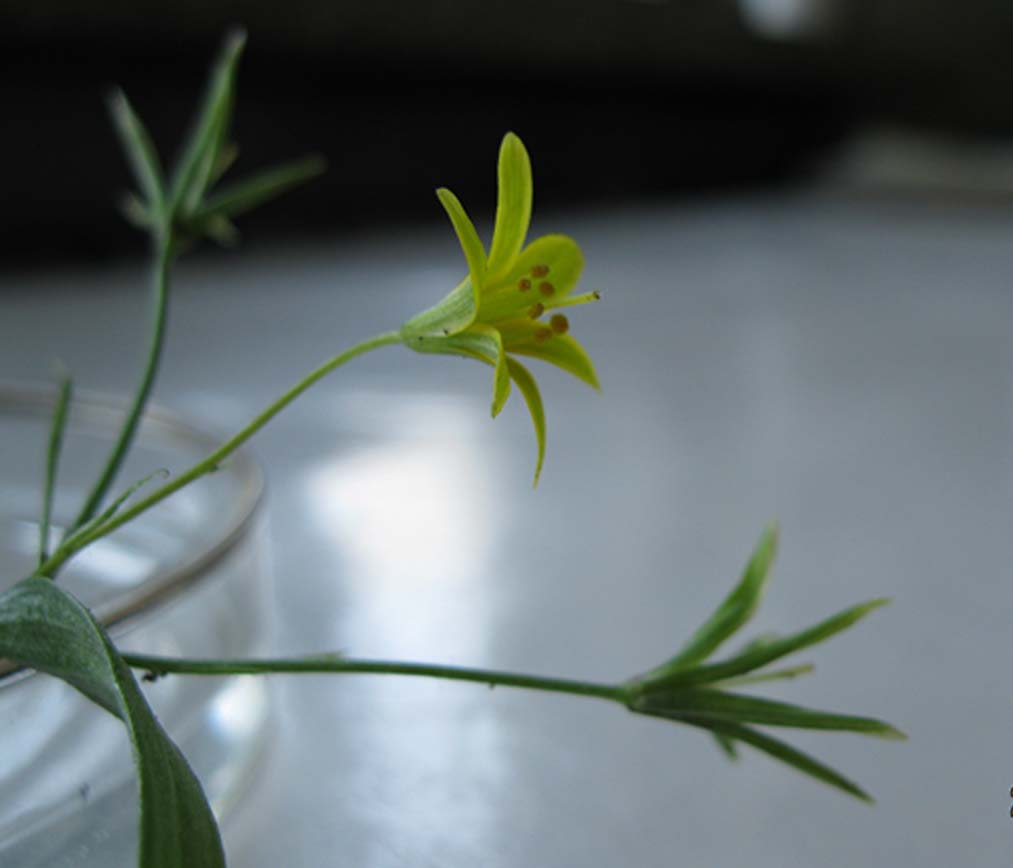

The Schedule of Pollen Presentation and Pollination Adaption in an Early Spring Ephemeral Plant Gagea nigra
# Co-first authors
Received date: 2015-11-02
Accepted date: 2016-01-22
Online published: 2016-09-27
Gradual pollen presentation is an adaptive strategy in flowering plants that limits pollen removal with high pollinator visitation rate. High visitation rates may favor plants presenting pollen gradually in many small doses and potentially enhance male reproductive success given that pollen grains could be donated to more different individuals. Here we studied the pollen presentation schedule and pollination adaptation of an early spring ephemeral plant, Gagea nigra, by investigating flower characteristics, pollinators and breeding systems in a natural population in Xinjiang Province, northwestern China. (1) The flowering period of single flowers was about 5 to 7 days; flowers open during the day and close at night. The anthers release pollen in the sequence of one by one and split longitudinally like a zipper, lasting 4-6 days. (2) The breeding system of the species was mainly outcrossing and partial selfing. Flies and hoverflies were the main pollinators, with mean visitation rate was 0.141±0.078 times per flower per hour. (3) During pollen presentation, the pistils continued to grow. Thus, the position of stigmas experienced three stages: below stamens, as high as stamens and higher than stamens. In the middle stage, with stamens and stigma at a similar height, the opening and closing of the single flowers during the day and night push the stamens and the stigma closely, thereby facilitating automatic self-pollination. (4) Under a scarcity of pollinators, the gradual pollen presentation in G. nigra extended the period of pollen release, elongating the time for pollinator visits that may reduce the risk of pollination failure, instead of an adaptation to abundant pollinators. Such a gradual pollen presentation strategy in terms of waiting for pollinators and risk of spreading may be widespread in many early spring flowering plants in Xinjiang.

Rongqian Zheng , Zhenzhen Hou , Aiqin Zhang . The Schedule of Pollen Presentation and Pollination Adaption in an Early Spring Ephemeral Plant Gagea nigra [J]. Chinese Bulletin of Botany, 2016 , 51(5) : 594 -600 . DOI: 10.11983/CBB15194
| 1 | 艾沙江·阿不都沙拉木 (2012). 伊犁郁金香的繁殖生物学特性及其生态适应对策. 博士论文. 乌鲁木齐: 新疆农业大学. pp. 25-29. |
| 2 | 陈家瑞 (1991). 植物孢粉染色技术综述及其应用. 植物学集刊(第五集). 北京: 科学出版社. pp. 269-276. |
| 3 | 黄双全, 郭友好 (2000). 传粉生物学的研究进展. 科学通报 45, 225-237. |
| 4 | 黄双全 (2012). 二十一世纪中国传粉生物学的研究: 良好的开端. 生物多样性 20, 239-240. |
| 5 | 黄云兰, 安秀峰, 师东, 张爱勤 (2012). 新疆荒漠植物耳叶补血草的爆发式开花式样与传粉模式. 生物多样性 20, 368-375. |
| 6 | 刘建华 (2009). 沙生蝇子草雄性先熟及花粉序次呈现的生态适应意义. 硕士论文. 乌鲁木齐: 新疆农业大学. pp. 17-19. |
| 7 | 陆婷, 谭敦炎 (2007). 动物传粉植物花粉呈现时序的进化意义. 生物多样性 15, 673-679. |
| 8 | 曲荣明 (2007). 沙地中植物的传粉对策——毛乌素案例研究. 博士论文. 北京: 中国科学院植物研究所. pp. 68-75. |
| 9 | 王莉, 程芳梅, 陆彦, 金飚 (2015). 裸子植物传粉滴研究进展. 植物学报 50, 802-812. |
| 10 | 袁明, 瞿礼嘉, 王小菁, 钱前, 杨维才, 王台, 孔宏智, 蒋高明, 种康 (2014). 2013年中国植物科学若干领域重要研究进展. 植物学报 49, 347-406. |
| 11 | 朱俊义, 张力凡, 沈鹏, 任保青, 梁宇, 陈之端 (2014). 桦木科植物花柱适应风媒传粉的特征. 植物学报 49, 524-538. |
| 12 | 张大勇 (2004). 植物生活史进化与繁殖生态学. 北京: 科学出版社. pp.154-158. |
| 13 | Barrett SCH, Jesson LK, Baker AM (2000). The evolution and function of stylar polymorphisms in flowering plants. Ann Bot 85(S), 253-265. |
| 14 | Castellanos MC, Wilson P, Keller SJ, Wolfe AD, Thomson JD (2006). Anther evolution: pollen presentation strategies when pollinators differ.Am Naturalist 167, 288-296. |
| 15 | Cruden RW (1977). Pollen-ovule ratios: a conservative indicator of breeding system in flowering plants.Evolution 31, 32-46. |
| 16 | Douglas KL, Cruden RW (1994). The reproductive biology of Anemone canadensis: breeding system and facilitation of sexual selection.Am J Bot 81, 314-321. |
| 17 | Harder LD, Thomson JD (1989). Evolutionary options for maximizing pollen dispersal of animal-pollinated plants.Am Naturalist 133, 323-344. |
| 18 | Harder LD, Wilson WG (1994). Floral evolution and male reproductive success: optimal dispensing schedules for pollen dispersal by animal-pollinated plants. Evol Ecol 8, 542-559. |
| 19 | Henning T, Weigend M (2012). Total control-pollen presentation and floral longevity in Loasaceae (blazing star family) are modulated by light, temperature and pollinator visitation rates.PLoS One 7, e41121. |
| 20 | Li XX, Wang H, Gituru RW, Guo YH, Yang CF (2014). Pollen packaging and dispensing: adaption of patterns of anther dehiscence and flowering traits to pollination in three Epimedium species.Plant Biol 16, 227-233. |
| 21 | Richard TE, Stephenson AG (1989). Pollen removal and pollen deposition affect the duration of the stamina and pistillate phases in Campanula rapunculoides. Am J Bot 6, 532-538. |
| 22 | Robertson AW, Lloyd DG (1993). Rates of pollen deposition and removal in Myostis colensoi.Funct Ecol 7, 549-559. |
| 23 | Snow AA (1986). Pollination dynamics in Epilobium canum (Onagraceae): consequences for gametophytic selection.Am J Bot 73, 139-151. |
| 24 | Spira TP, Snow AA, Whigham DF (1992). Flower visitation, pollen deposition and pollen-tube competition in Hibiscus moscheutos (Malvaceae).Am J Bot 79, 428-433. |
| 25 | Thomson JD, Wilson P, Valenzuela M, Malzone M (2000). Pollen presentation and pollination syndromes, with special reference toPenstemon. Plant Species Biol 15, 11-29. |
/
| 〈 |
|
〉 |